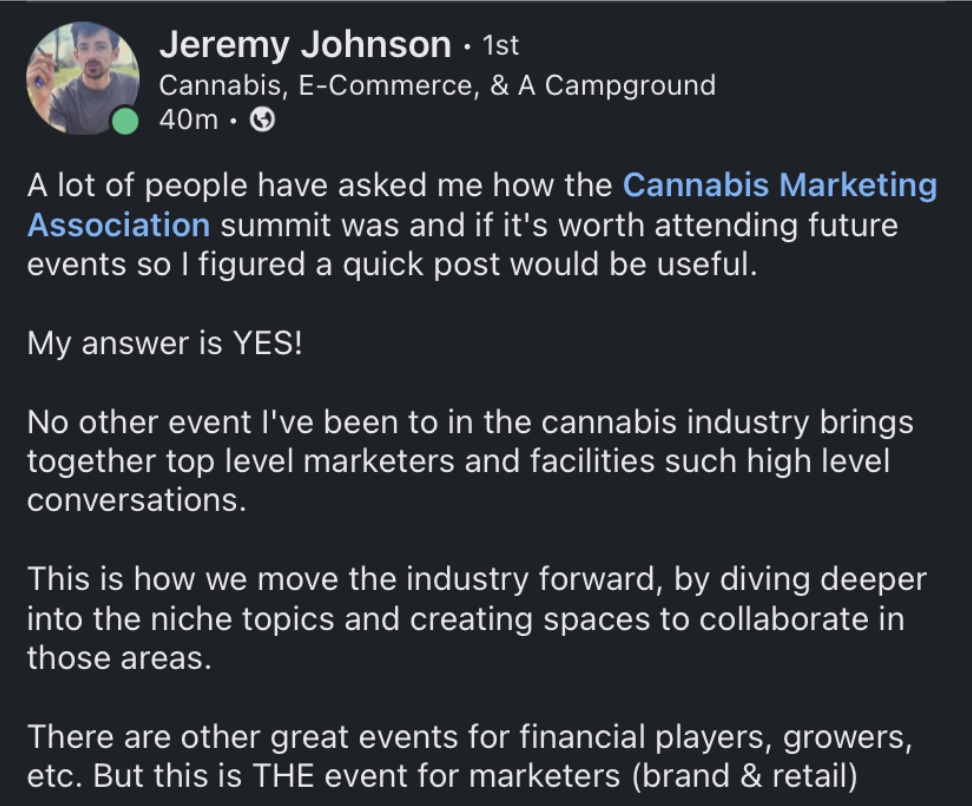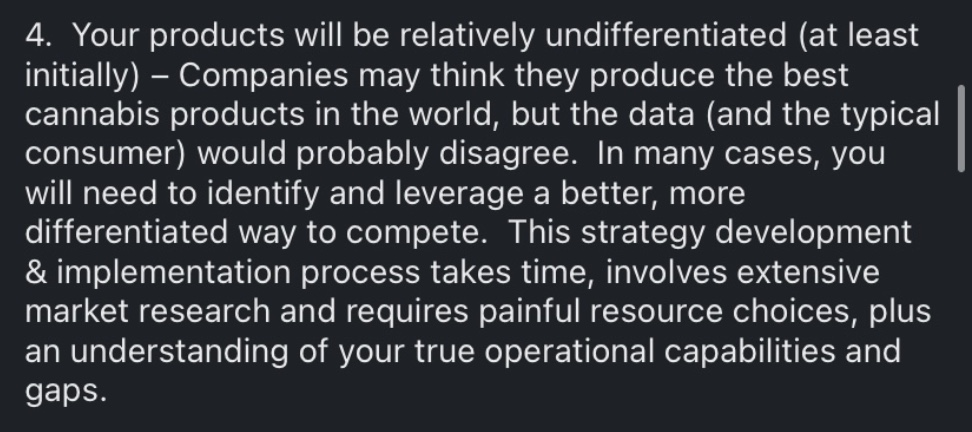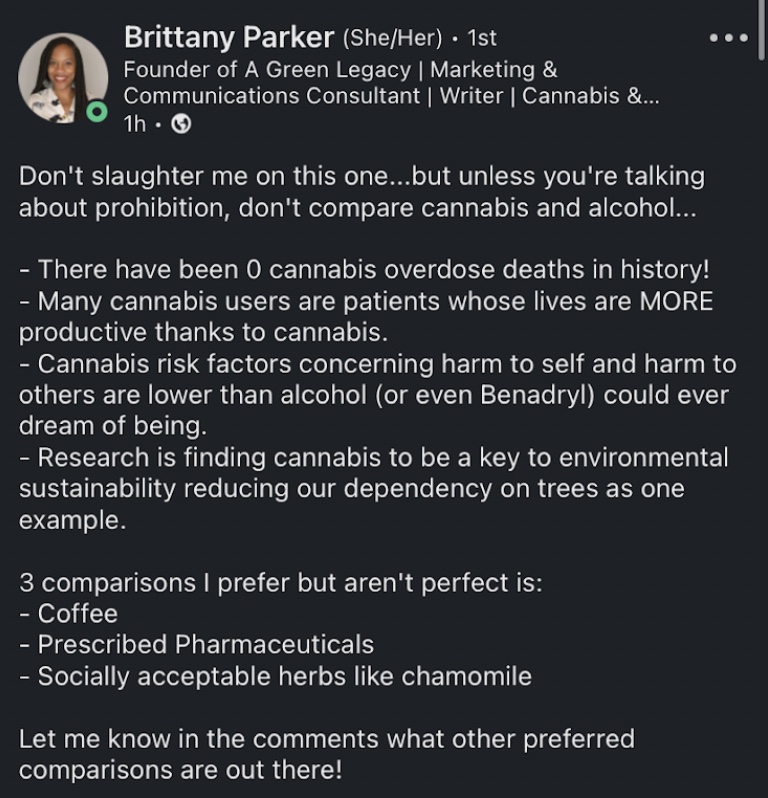14 June 2022 | Cannabis
Cannabis needs a rebrand, standing out in the marketplace, and comparing cannabis to alcohol.
By Kaitlin Domangue
Jeremy’s post isn’t the first one I’ve seen discussing the awesome takeaways from The Cannabis Marketing Association’s recent event.

The Green Paper is heavily-focused on events and one thing we’ve heard is that cannabis events are stale. The same several speakers are always at the same events. The same conversations are happening. The same sponsors, the same topics, the same everything is happening year after year.
And it’s fun to network and be with other industry professionals, but oftentimes these events don’t go beyond that, though they may promise to.
I didn’t get to attend The Cannabis Marketing Association’s recent event, but after all the organic feedback I’ve heard: I’m definitely making it a priority next year.
I think one of the primary reasons CMA’s event was so successful is because they are focused on cannabis marketing only.
Larger events like MJBizCon cast a wider net. While this approach isn’t bad by any means, it can be hard to zero in and really spend time on a particular topic. Larger panels usually have to limit the number of questions asked by audience members, too, preventing natural conversations that would otherwise be in place.
The Green Paper hosted an event in March and it was a small, community-style event. Full transparency: we actually veered a little bit from our original plan of an executive-style event, in part because there was a glaringly-apparent need for smaller, more focused events in cannabis.
We received great feedback from our guests and the consensus was our conversation felt natural and engaging. We were able to truly talk to our audience and we didn’t just talk at them.
We dove deep into various topics, focusing heavily on the California market, and what it looks like for operators in that state.
Given our event was in California, our audience was deeply engaged in the conversation because everything we talked about is their life every single day.
Our fireside speaker was Scott at Pantry Foods, and he’s a California operator, too, and it further connected the audience with The Green Paper.
What I’m thinking 🧠
What if the cannabis industry started to treat every sector of this space as a microindustry? Because it’s essentially what they are.
When you work for a cannabis payment processing company, for example, you’re not always flexing your cannabis muscles. You’re flexing your fintech muscles. Attorneys aren’t talking about the endocannabinoid system, they’re studying the law surrounding cannabis.
This is obvious, but it seems like tailoring events towards the general cannabis industry leaves opportunities on the table. We should keep these larger events going because let’s face it: they’re a lot of fun and come with great opportunities.
But I think by niching down a bit in addition to these bigger events, we can refocus cannabis events and use them to each microindustry’s advantage.
Stop the same old, same old

The above text is a portion of cannabis advisor, Mitchell Osak’s, post on LinkedIn. He wrote 5 inevitable truths for the cannabis industry, this one obviously being number 4 (I’m always here to help state the obvious, y’all).
“Your products will be relatively undifferentiated. At least initially.” This line sums up a huge portion of my feelings towards the way cannabis companies position themselves.
Many companies use important and meaningful attributes, like woman-owned or veteran-owned, as their primary differentiator. But looking to your right and left, you’ll see a lot of veteran-owned and women-owned brands. Cannabis companies have to find alternative and additional methods of differentiation to truly stand out.
I think one way a cannabis brand can stand out is by nurturing its B2B relationships.
Let’s use flower brands as an example. Cultivators spend a lot of time appealing to the cannabis consumer. It makes sense, as their flower will be on the shelves of retailers and available for customers to purchase. Having a strong brand presence is important. It’s vital, even.
But some cultivators neglect their B2B relationships which put them in front of the consumer.
This is an area where being aware of operational gaps, like the LinkedIn post mentioned, can help. Mishandling retail accounts as a cultivator is a surefire way to permanently damage a cultivator’s brand. Retailers and on a smaller level, manufacturers, are the cultivator’s true customers.
Non-vertically integrated cultivators rely on retailers to stock their products, and even vertically-integrated operators need shelf placement in more stores than just their own.
So what happens when a cultivator doesn’t have a reliable way for retailers to order? Or when a label is inaccurate? Or an order is late? The retailer probably won’t be buying again because it’s a hassle to purchase from them. Similar sentiments can be said for cultivators to manufacturers, manufacturers to retailers, retailers to cultivators, etc.
What I’m thinking 🧠
B2B relationships matter more than some operators realize and might help your brand stand out, beyond appealing to the consumer through branding and marketing.
You can appeal to the consumer all you want, but many of your B2B accounts hold the true keys in terms of your success.
This conversation makes me think of something that happened about a week ago.
Karson Humiston, the founder, and CEO of the cannabis hiring platform, Vangst, recently posted about an email interaction one of her team members had with an ungracefully-aging dispensary owner. It’s incredibly vile, so I’m not repeating it here, but click ^^^ that link to see what I’m talking about.
After that happened, the Senior Vice President of Marketing and Communications at Leafly rightfully pulled his listing from Leafly’s online directory. Leafly generates tons of traffic for the industry, generating over 40 million page views a month.
Removing a retailer’s listing from a platform like this will, no doubt, have a residual impact on the business. Maybe it’s small or maybe it’s detrimental, but it will be there to some degree.
The dispensary owner’s initial B2B interaction with Vangst sparked another B2B interaction (Leafly) and this one hit him where it hurts.
This was a pretty extreme example, but my main point is that: oftentimes, your brand’s best differentiator is behind the scenes: your B2B accounts.
Comparing cannabis to alcohol – the right way

I totally agree with Brittany, and I often find myself hesitating to compare alcohol and cannabis.
I think it’s entirely important to compare the two, though, because alcohol is so normalized in today’s society and cannabis isn’t. Comparing the two allows us to absorb the absurdity of cannabis being restricted while alcohol isn’t. People also use alcohol recreationally, as they do cannabis.
But comparing the two in an improper setting might set the industry and advocates one step forward and two steps back.
As Brittany said, there haven’t been deaths from cannabis overdoses. The handful of deaths that have been legally attributed to cannabis has been argued by numerous health experts, who say cannabis can’t be painted as the primary cause. Roughly 95,000 people die every single year from alcohol-related causes in the United States.
A bit about me: I’m a medical cannabis patient in Missouri. I have chronic anxiety and have been aggressively treated for it since I was 5 years old. I tried cannabis and immediately noticed the effect it had on my anxiety, in a way no other medication had. I was also diagnosed with ulcerative colitis in 2016. I struggle with a loss of appetite and nausea, which cannabis helps me manage.
So I’m especially prone to comparing prescription pharmaceuticals with cannabis. It’s in fact, all I know to do because cannabis literally replaced my pharmaceutical medication.
What I’m thinking 🧠
The reason we draw comparisons between cannabis and alcohol is that alcohol is socially acceptable and cannabis isn’t.
I think medical cannabis companies should focus on comparing cannabis with pharmaceutical medications. And honestly, most are already doing this.
The trickiness starts when you start talking about recreational operators. As Brittany said, we need to mostly save this comparison for discussions about prohibition.
Alcohol and cannabis operate similarly in the fact that they both allow consumers to unwind. Physiological and psychotropic effects begin to occur with both substances.
The stark difference, of course, is that alcohol is legal.
And… alcohol kills people every single day. More than 380 deaths per day in the United States alone from excessive alcohol use. Yet, cannabis operators are still fighting to be recognized as legitimate.
In my opinion, the industry should continue to compare the two when it comes to loosening the restrictions on cannabis and normalizing cannabis in society.